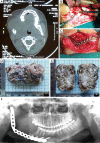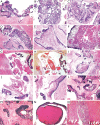Keratoameloblastoma or Kerato-odontoameloblastoma: report of its soft tissue recurrence with literature review
- PMID: 26807371
- PMCID: PMC4700246
- DOI: 10.3978/j.issn.2223-4292.2015.09.01
Keratoameloblastoma or Kerato-odontoameloblastoma: report of its soft tissue recurrence with literature review
Abstract
Keratoameloblastoma (KA) is a rare histological variant of the ameloblastoma with extensive keratin production within the odontogenic islands as well as in the fibrous stroma. Pindborg first reported it in 1970, since then only 18 cases have been reported in the literature. We report a soft tissue recurrence of KA, involving right posterior region of the lower jaw in a 27-year-old female.
Keywords: Ameloblastoma; ameloblast; keratin; mandible; odontogenic tumor; recurrence.
Conflict of interest statement
Figures








References
-
- Pindborg JJ, Weinmann JP. Squamous cell metaplasia with calcification in ameloblastomas. Acta Pathol Microbiol Scand 1958;44:247-52. - PubMed
-
- Whitt JC, Dunlap CL, Sheets JL, Thompson ML. Keratoameloblastoma: a tumor sui generis or a chimera? Oral Surg Oral Med Oral Pathol Oral Radiol Endod 2007;104:368-76. - PubMed
-
- Pindborg JJ. Pathology of the dental hard tissues. Philadelphia(PA): W. B. Saunders;1970:381-2.
-
- Altini M, Lurie R, Shear M. A case report of keratoameloblastoma. Int J Oral Surg 1976;5:245-9. - PubMed
-
- Altini M, Slabbert HD, Johnston T. Papilliferous keratoameloblastoma. J Oral Pathol Med 1991;20:46-8. - PubMed
Publication types
LinkOut - more resources
Full Text Sources
